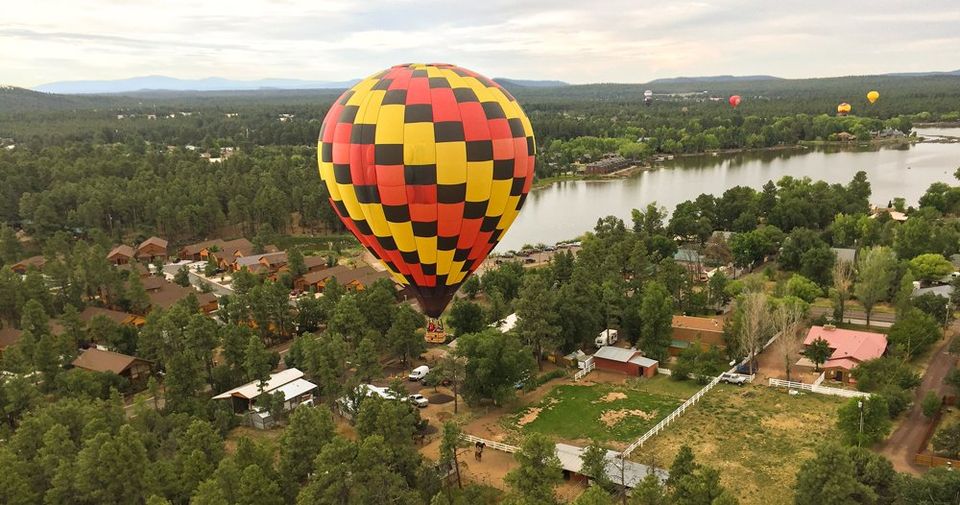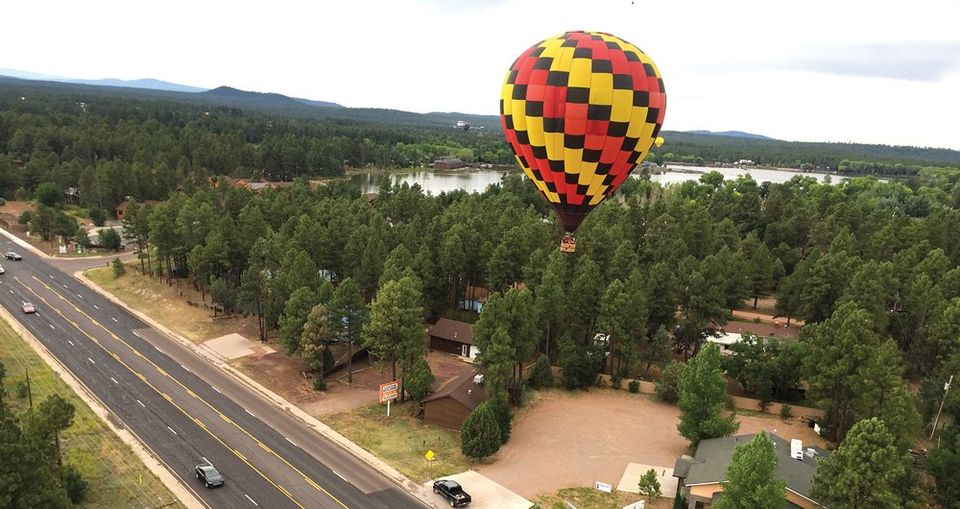Ballooning during the 2020 White Mountain Balloon Festival

As the ground quickly moved away from below us without a sound, the surreal feeling of losing all reference to what is moving and what is standing still was quickly punctuated with the sight of a soccer field light pole moving closer trying to bump our balloon -- or worse. In a matter of seconds, without any further bursts of BTUs from the propane “engine,” our crew of 3 aboard the airship named “Something Borrowed”, piloted by Ashley Hargrave, was free and clear of any poles, trees or any other obstacles tethered to terra firma and on our way to some unknown landing site.
You may have gathered already, or maybe even observed the squadron of hot-air balloons in the sky June 26-28, that the Third Annual White Mountains Balloon Festival actually took place this year in a limited capacity due to the Covid-19 pandemic. Mountain Meadows Park hosted the event that saw hot air balloons and their crews flying in the mornings and conducting a balloon “glow” event on Saturday night. Pilots and crews came from across the Southwest, including the Valley and veterans of the world-famous Albuquerque International Balloon Festival from New Mexico.
The website for the event proudly states in the headlines that the Festival takes place at 7,000 feet in the world’s largest contiguous Ponderosa pine forest in the world. And they still had 17 intrepid pilots and their chase crews show up -- without cherry picking trucks or lots of rappelling gear to retrieve balloons from trees.
Ponderosa pine trees instead of paved runways stood out as just one of many unique aspects of balloon flights compared to normal fixed wing or rotor aircraft. We quickly discovered a number of unknown factors involved with flying hot air balloons, many as basic as “where are we going to land and have the chase crew pick us up?”.
That’s just the last variable that the pilot has a lot less control of than you would think. Obviously, the pilots are extensively trained and know way more than a novice can even imagine but if you are a control freak and need to be able to manipulate your situation all the time, becoming a lighter-than-air pilot might require some psychiatric assistance.
As alluded to earlier, the take-off from the northeast soccer field at Mountain Meadows was a little unnerving as Pilot Hargrave had to inflate our balloon’s envelope more than what is needed at lower elevations due to the lower density of our mountain air. As soon as she ordered lift-off, her ground crew used ropes to maneuver the balloon clear of the light standards and we were up, up and away.
Upon normal take-offs from the ground, even in helicopters, you experience increased gravitational forces pushing against the seat as you defy the laws of gravity with the help of fuel tanks full of high-octane aviation fuel. Once airborne and moving in a consistent direction, those g-forces go away.
But the balloon takeoff allowed you to watch the Earth fade slowly below you without the big change in the g-force, fooling your brain into thinking it was actually the rest of the world that was doing the moving and you were just stationary as you watched the ground crew get smaller and less significant. And once we levelled off less than a couple hundred feet above the ground, it was quiet enough to communicate with folks on the ground -- “No airmail today, sorry!”- Flying this low afforded a great view of the ground below but didn’t offer a great panoramic shot until we had to climb to avoid another balloon.
The myth that you don’t feel the wind in a balloon fell quickly when we experienced a change in wind strength and direction as our pilot changed altitude to actually steer the balloon. Every few minutes, Pilot Hargraves pulled the cord that fired up the burners making the air in the balloon less dense and more buoyant than our surrounding atmosphere, following in the footsteps (?) of brothers Joseph and Etienne Montgolfier who first demonstrated lighter-than-air flight with a sheep, duck and chicken in 1783. Human passengers followed within months in Paris, France.
The Frenchmen didn’t have the convenience of three liquid propane filled tanks in their basket or a two-way radio to communicate with the chase vehicle below, letting them know where the wind is taking us. And the early aeronauts didn’t have to pass a Federal Aviation Administration certification test or have their balloons, baskets and burners inspected periodically to be able to fly their airships like they do today.
Some might say that the balloons are at the mercy of the winds but the pilots displayed their skills by spreading out after taking off, with some pilots, including ours, accomplishing a “splash and dash” by dipping their baskets into a nearby lake (Rainbow, in our case) and lifting off again quickly so as not to collide with the shoreline cottonwoods. Our basket was able to erupt out of the water quickly thanks to the fast-draining wicker construction and Pilot Hargraves’ convincing use of the burner throttle cord.
Balloon flights based in the Valley desert can choose their takeoff point so the current winds will blow them towards a safe landing site. However, the White Mountain Balloon Festival has always taken off from the Mountain Meadows complex so landing sites cannot be planned ahead of time. This certainly didn’t bother any of the pilots or crews who flew for the Festival, which typifies a common attitude amongst balloon pilots. They seemed ready -- and comfortable -- to improvise more than fixed-wing pilots, many of whom are required to file a detailed flight plan.
Lighter-than-air pilots may have a general idea of the wind directions at different altitudes but these are always changing, making a balloon pilot's job trying to find the right wind direction in some ways more active than flying a modern jetliner where a pilot just has to turn a yoke or engage the autopilot.
Flying balloons in unfamiliar areas makes it a challenge for the chase crew to figure out which roads would lead to a landed balloon -- if there are even roads nearby in our more remote White Mountains area. And how many meadows, without closely guarded barbed wire fences, can you name that are void of all pinyon or juniper trees?
As we passed over White Mountain Boulevard just north of Lake of the Woods, it looked like the Jacques Marsh area would be a good landing spot, if we could avoid the powerlines on the south. However, a sudden change in the wind direction as we descended pushed us to the west until we were flying directly over and in line with another powerline that was aligned with the Penrod bypass road. Pilot Ashley Hargraves quipped that sometimes she thought for sure her basket was magnetized towards powerlines as she used our last tank of gas to keep us aloft long enough to float past the powerlines on a flight path east of the Penrod turnoff.
Our chase vehicles fell behind the balloons somewhat -- as a ditch demonstrated the limitations of ground-based vehicles -- but maintained radio contact with the balloon as we started looking for a landing spot. Pilot Hargraves spotted a balloon on the ground ahead in our flight path that had found a good spot so she started descending, only to spot a barbed wire fence perpendicular to our landing path. A quick blast of flames made sure we cleared the fence with plenty to spare and we landed close enough to the other balloon for their crew to catch our basket and soften the landing.
Sierra Propane again was an Elite Sponsor this year, providing all of the liquid propane for the balloons, according to the Town of Pinetop-Lakeside Community Services Manager Tony Alba. Whispering Pines Resort and Summit Healthcare were the other Elite Sponsors for the third annual event. Alba and other town staff conducted health screening and questionnaires prior to any media or pilots participating in the event. Next year’s event is likely to draw even more balloons on the last weekend of June, since the crews enjoy the cool mountain weather compared to the warm Phoenix area. So, put the balloon festival on your calendar for June 25-27, 2021.
Tips for riding in a hot air balloon:
Don’t ask where the seatbelts are
Don’t ask to go back to your departure gate so you can go to the bathroom real quick
Don’t ask the pilot questions when she is talking on the radio to the ground crew or is trying to avoid a premature landing.
Do ask if you are in the way of the pilot getting to the burner throttle or the top vent rope
Do take more pictures than you think you actually need.
Don’t worry about taking the perfect picture if it gets in your way of admiring the scenery
Do hold onto your phone tightly, especially when performing a splash and dash
Don’t wear your nice leather shoes that shouldn’t get wet
Bend your knees when landing (or set up a chiropractor appointment for the week after your flight)
Go to the bathroom before take-off












